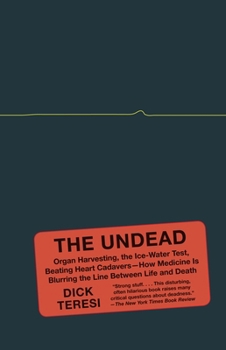The Undead: Organ Harvesting, the Ice-Water Test, Beating-Heart Cadavers--How Medicine Is Blurring the Line Between Life and Death
Select Format
Select Condition 
Book Overview
What is death, and how do people in the medical profession determine it? In this fascinating examination of the increasingly blurred line between life and death, consciousness and unconsciousness, science journalist Dick Teresi introduces us to the coma specialists, organ transplant surgeons, ICU doctors, and many others who are faced with this issue daily. The Undead describes how death has been determined through the ages, beginning with the ancient Egyptians and leading to the 1968 Harvard Medical School paper that indirectly stated that death was not cardiopulmonary failure, but a "loss of personhood"--i.e., brain death. Teresi explores the consequences of new technologies that extend people's lives but which conflict with society's desire to see them declared dead before their time.
Format:Paperback
Language:English
ISBN:1400096111
ISBN13:9781400096114
Release Date:December 2012
Publisher:Vintage
Length:368 Pages
Weight:0.66 lbs.
Dimensions:0.8" x 5.3" x 8.0"
Customer Reviews
1 rating
Dangers in Organ Donation
Published by Ron Reardon , 6 years ago
This book explains the wide variation in human resuscitation capabilities in hospitals. Because of the variability in the experience of medical staff attending emergency life saving events and the diversity of resuscitation equipment at their disposal, outcomes vary considerably. Add to this the lack of standardized guidelines as to when a patient should be declared “dead”, presents questions and concerns about exactly when organs are then harvested for transplant. This creates an atmosphere of cross purposes between the medical team responsible for saving lives in the emergency room and the medical team eagerly awaiting organs for transplant too another patient. The scenario is very worrisome and should prompt potential organ donors to reconsider their wishes in that regard.





